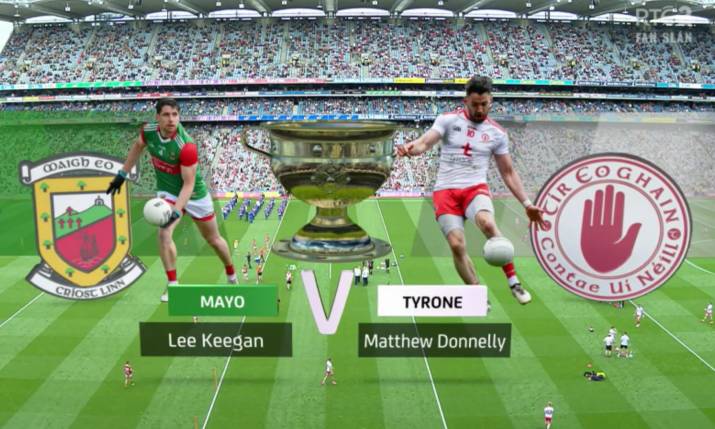Beyond the game: How social media consumption is shaping sports broadcasting according to Vizrt

Viz Arena’s AR graphics displaying Gaelic football players Lee Keegan and Matthew Donnelly in a Mayo v Tyrone match
By Andrew O’Neil, Vizrt head of sports, EMEA and APAC.
In 2023, sports broadcasters navigated the challenge of attracting audiences in the attention economy. This won’t change moving into 2024. Audiences are being bombarded with different options across different platforms and devices more than ever. Coupled with a clear shift in the consumption habits of younger generations, the question becomes how can content stand out in this ever-increasingly competitive environment for eyeballs?
Concise, captivating, data-rich storytelling across multiple platforms. Producing this kind of visual storytelling consistently in a way that reaches these fragmented audiences requires creativity; and some special tools.
Changing consumption habits
According to Forbes, a whopping 4.9 billion people currently use social media around the world, with the expectation that this number will increase to 5.85 billion by 2027 [Wong 2023]. This is not to say that social media consumption and demand for content will surpass the need for traditional broadcasting, but rather that both can work in unison.
If you aren’t leveraging your social platforms to capture audiences and drive digital engagement, you are falling behind competition. Especially as the technology to achieve incredible results is already here. And in some cases, you’re able to use the technology you have in a different way, to produce better.
The right tech retains attention
For example, Sky Sports Germany expanded and diversified its coverage of the 2023 Super Cup by natively streaming 9:16 coverage from its live production system to TikTok. The broadcaster created ‘watch parties’ with sports influencer style pundits and engaged thousands of new audience members without adding any new technology to make it happen.
By fully streaming vertically through the app and traditional linear broadcast, the broadcaster expanded its reach and gained new viewers. By having the right technology in place, it also kept a consistent output of engaging and enriched graphics alongside player data and performance history, match analytics and exclusive camera cuts.
Utilising these visual elements in content creation is proven to retain viewers’ attention. Deloitte’s 2023 Digital Media Report reveals the ‘blended realities’ of Millennials and Gen Z’ers in their consistent engagement with the online world [Westcott et al., 2023]. The report finds that younger generations’ digital experiences are characterized by a desire for entertainment, immersion, and connection, which makes the ‘watch parties’ a clever approach to engage and excite this audience.
An independent survey commissioned by Vizrt reaffirms this: 83% of sports fans agreed graphics and virtual elements made them feel more immersed and interested in the sports content regardless of how they were watching.
But they are watching more across social media, with 68% of Gen Z and 47% of Millennials primarily using social platforms for sports content consumption. The takeaway is that it is not just about giving audiences the game, but further immersing viewers with digital elements and entertaining them with analytics and commentary.
The interactive experience
Forbes’ research also indicated that users spread their digital footprint across six or seven social media platforms each month, and the most popular place to find short-form video content is YouTube, with 68% of 15 to 24 year olds consuming it daily [Ofcom 2023]. Combined with the ease of connecting YouTube to a TV, multiple platforms can be used simultaneously; live streaming events or games on the big screen, while commenting and interacting with people online.
In fact, YouTube is seeing an increase in people watching its content from home, and in 2024, the platform will focus on better serving users watching from their living room. Presenting at the latest DPP Leader’s Briefing, YouTube head of sport and primetime channels EMEA, Rob Pilgrim, shared that viewers tuning in from the living room spend an average of 62 minutes consuming videos, which is longer than those watching from mobile devices.
Broadcasters should be considering how to leverage these platforms in addition to linear play out, to ensure they’re reaching the maximum number of viewers possible, and with the technology available, diversify the possibilities in audience participation and interaction. Tools to create polls where fans can vote at home and results can be shown on-screen, or to enable viewers to rate player performance, displaying fan-generated content, alongside displaying conversation analysis with social media data.
But how can this be planned for the sporting events of 2024? Let’s take the Olympics, for example; next year, not only will surfers and skateboarders still be competing, but so will sport climbers. Climbing has enjoyed a wave of popularity among young people in the past few years, and sports broadcasters can make the most of this rise in interest and attract younger viewers to its Olympic coverage.
Reaching potential audiences can be done leading up to the games in Paris and after as well. From the excitement of athletes being qualified for the competition to a rundown of performances, discussions, analyses, and conversations can happen on the big screen, as well as online from the sofa.
Establish enduring connections
By recognising the value of leveraging social media to establish a strong presence to convert and sustain long term audience engagement, rather than something for fleeting virality, broadcasters can ensure sustained relevance in the evolving landscape of digital media consumption.
The future of media engagement involves navigating the delicate balance between capturing attention and delivering meaningful content. Although social media provides an opportunity to increase the ways sports fans engage with content, this year’s coverage highlights and achievements have proved that sports broadcasters must rely on two things: the people who envision, plan, and execute engaging content, and the technology that supports that vision.

